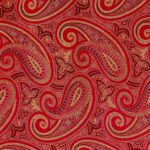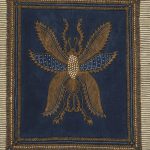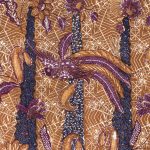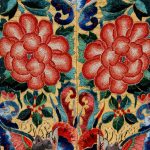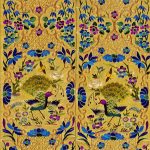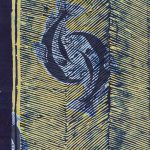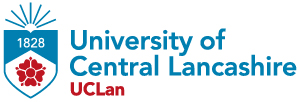This is a commercial sample of a type of fabric known as ‘madras’, which at the time this fabric was produced referred to a lightweight cotton with a woven check. The check could form an all over pattern, as seen in this example, or it could be woven as borders or in stripes with plain […]
View moreThese suits acted as a protective layer that would cover visitors own clothing whilst they enjoyed the Fun House at Blackpool Pleasure Beach. They take the form of a robust cotton overall in geometric, colour blocked panels in brown, pink, green and yellow. the cuffs have a contrasting yellow button at each wrist and a […]
View moreA selection of jacquard designs and fabric samples produced by Birtwistle &Oddie Ltd of Prospect Mill, Wharf Street, Blackburn. The company was founded at Prospect Mill in 1907 by H. H. Birtwistle and A. M. Oddie. The company remained there until 1972 and was known for producing jacquard woven brocades, and later cotton and rayon […]
View moreExploring the connections between two iconic dyes and the story of William Gatty and his home; Elmfield Hall in Accrington.
View moreThese panels from Indonesia or Borneo show the fourteen stages of the batik method required to make this relatively simple design of a beetle using blue and brown dyes. A more detailed design and wider range of colours would add many more steps to the process and require even more patience and skill to create. […]
View moreThis intricately patterned sarong from Indonesia is a beautiful example of the batik method. The complex design features birds, spiders, beetles and other insects worked in shades of deep blue and brown. Each colour would require a new layer of wax to be laid over the relevant sections of fabric, dyed, then washed free of […]
View moreThis commercial sample was designed and manufactured in Lancashire using industrial printing processes to closely imitate the effect of a traditional, hand worked batik or wax resist dyeing. The design features a simple colour palette with geometric patterns as the backdrop for large and graphic fish motifs. Resist-dyeing is an ancient process and flourished in […]
View moreSleeve bands were decorative cuffs and would have decorated the bottom edges of the sleeves on a traditional robe. They often featured designs that were a near perfect mirror image of one another so that when the hands were clasped in front of the body and tucked slightly into the opposite sleeve, the designs would […]
View moreSleeve bands were decorative cuffs and would have decorated the bottom edges of the sleeves on a traditional robe. They often featured designs that were a near perfect mirror image of one another so that when the hands were clasped in front of the body and tucked slightly into the opposite sleeve, the designs would […]
View moreThis adire cloth was produced in Ibadan, Nigeria, and uses cassava starch paste as a resist to create the pattern using indigo dye. The technique is similar to other resist techniques such as batik, but using cassava starch instead of wax. This sample is now held in the Gawthorpe Textiles Collection but was originally collected […]
View morePanel of laid work embroidery with a design of peacocks and an urn of flowers, worked by Rachel Kay Shuttleworth in 1921. This framed panel of embroidery is worked in a technique known as laid work where long stitches are laid down first to fill in the shapes and then secured with smaller couching stitches […]
View more


